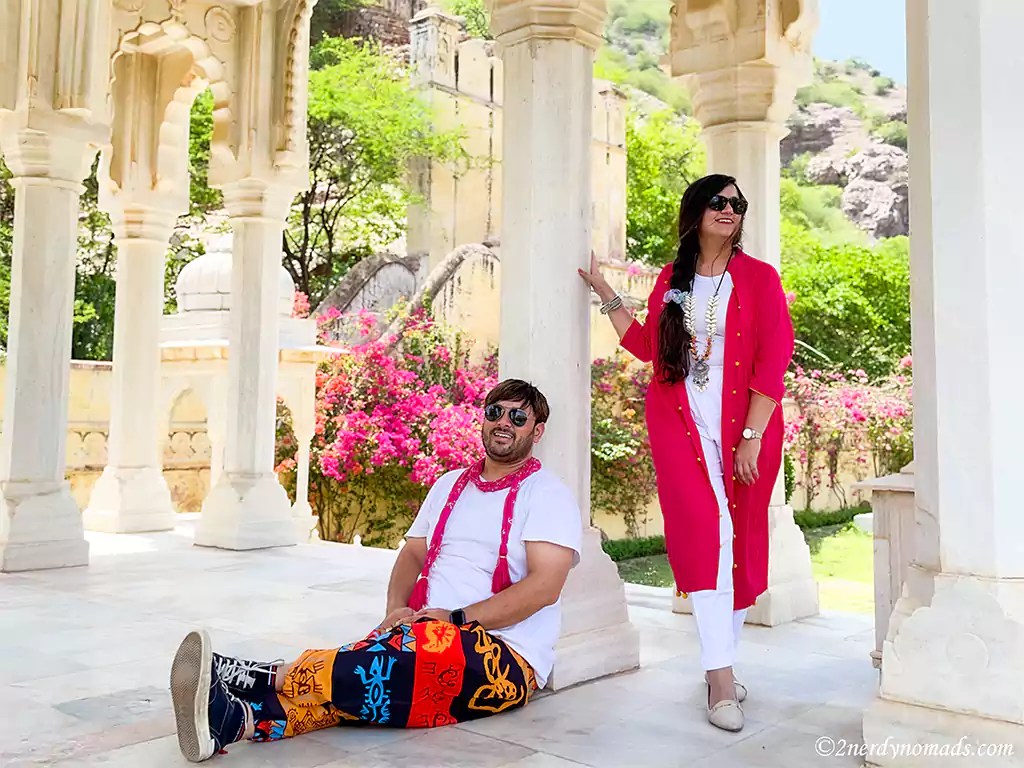Ah, Jaipur! My heart skips a beat every time I think of this enchanting city, our absolute favorite in all of India. The Pink City that never ceases to surprise us, no matter how many times we visit. Be it the colorful bazaars or the elephant ride in front of Amer fort; or the grand palaces adorned with local artisanal work, everything will tell you a story.
Our love affair with this city began years ago, when we did a random weekend road trip from Delhi and got lost in the city’s charm; and ever since with each visit, it deepens as we uncover yet another hidden gem. I think it’s like a treasure chest, revealing its secrets one at a time, and we here to share our favorite hidden gems in Jaipur with you!

In this blog, we’re excited to share those hidden spots that aren’t in the typical guidebooks but deserve a special mention. Ready to uncover Jaipur’s best-kept secrets with us?
Shri Jagat Shiromani Temple
We generally tend to visit Amer Fort which is of course the most famous UNESCO World Heritage site, but do you know there is a magnificent temple, dedicated to Lord Krishna and Meera Bai, located just behind it? Nestled quietly in the heart of Amer, the Jagat Shiromani Temple is a true hidden gem in Jaipur.
We were thrilled to know that it took Queen Kanakwati, the wife of Raja Man Singh, nine years to build this temple, from 1599 to 1608 AD. What makes it even more special is that she built it in loving memory of their son, Jagat Singh, who sadly passed away at just 34 years old. The Queen wanted the temple to be famous all around, so she named it Jagat Shiromani, which means “jewel on the head of Lord Vishnu.”
Also known as Meera Bai Temple, Jagat Shiromani is a key part of Amer Town’s history. Inside, you’ll find a statue of Lord Krishna that holds significant importance in Hinduism. According to local beliefs, this statue is the same one that the Meera Bai worshipped in Mewar, 600 years ago (wow😲).
We recommend visiting the temple in the early morning for the 7 AM prayer and prasad. It’s a peaceful time to experience the temple’s serene atmosphere. We found few locals; they were warm and welcoming; had a good chat with them and learned that the temple’s architecture is an amalgamation of Hindu, Jain, Mughal and South Indian styles(so fascinating). After the prayer, you can take some time to admire the intricate carvings and beautiful architecture or sit quietly in the courtyard and enjoy the tranquility.
Some points to keep in mind while visiting the temple:
- There is no entering fee for visiting the temple.
- Temple is open from 6am-1pm and 4pm-8pm daily.
- Be respectful towards the local culture and dress properly. Avoid wearing short dresses or Bermudas or too exposed styles.
We would say this is one of the best free things to do in Jaipur, a perfect spiritual escape, a must-visit for those looking to uncover Jaipur’s lesser-known treasures.


Gatore Ki Chhatriyan
Ever wondered how our Maharajas preserved their legacy and keep their memories alive for centuries? Well, to experience this you must add the most graceful yet another less explored gem in your Jaipur itinerary- ‘Gatore ki Chhatriyan.’
Nestled at the foothills of the Nahargarh Fort, this serene site is a hidden treasure. Built in the honour of the Rajput kings, the place offers a glimpse into the city’s royal past. The Kachwaha Rajput dynasty, which ruled at Gatore ki Chhatriyan, maintained these royal cremation grounds and since 1733, every Kachwaha king has been cremated here. The most interesting fact is that the Gatore complex is built according to Vedic architectural principles, featuring a blend of Indian and Persian styles.
On our visit we were struck by the elegance of this place. Each chhatri (cenotaph) is a stunning example of Rajput architecture, adorned with intricate carvings and domes. The place is open from 9am till 5pm. For a truly immersive experience, we would recommend visiting during the early morning or late afternoon (You may tip the guard for early access). It’s less crowded than other tourist spots, so you can really soak in the beauty and history without distractions. The entry ticket for the Indian Citizens cost INR 30 ($0.36) only while for foreigners its INR 300 ($3.5) per person.
This is one of the best things to do in Jaipur so add this to your itinerary if you’re a history buff or simply love exploring unique places. This is definitely worth your time.


Elefantastic in Jaipur: Ele Safari 🐘
Get ready to trunk up your Jaipur adventure because we stumbled upon the most delightful experience- Ele Safari!
Imagine this: you’re not just watching elephants; you’re getting up close and personal, playing, feeding, and even giving them a bath! It’s like a spa day, but for these gentle giants—and trust me, they know how to have a good time.
Located in Hathi Gaon (elephant village in Jaipur), Rajasthan, Ele Safari is an Elephant Interaction Program, one-of-a-kind experience, specially designed for Elephant fun and care. Founded by Mr. ILU, Ele Safari aim for the welfare of Asian Elephants in Jaipur, encourage eco-tourism and to provide elephants good health, proper shelter, and extensive care. The money raised through this program is primarily used to ensure the elephants receive the best possible care, from nutritious food and medical treatments to comfortable living conditions. Additionally, it supports the livelihood of their caretakers(mahouts).
From the moment we arrived, we were greeted by the friendly mahouts and, of course, the magnificent elephants. At first, I felt a bit nervous being so close to these giant creatures, but my fears quickly faded as we interacted with them. We got to play, feed, and even bathe the elephants, which was an incredible experience! Splashing water on them while they enjoyed their bath was pure joy😊.The ride was the icing on the cake, giving us a unique perspective of the surroundings.
We ended up spending around 2-3 hours here, though there was no strict time limit, and I found myself not wanting to leave. This experience not only gave us a glimpse into the lives of these incredible animals but also left an indelible mark on our hearts.
This is definitely one of the unique things to do with your friends and family especially if you are with kids around. So if you ever find yourself in Jaipur, make sure to add Ele Safari to your itinerary— it’s a journey you won’t soon forget.😊



Bejad Roti Thali at Masala Chowk
Our offbeat Jaipur adventure wouldn’t have been complete without indulging in some local cuisine, and Masala Chowk was the perfect place to do just that. It is a vibrant food court, with a series of open stalls arranged in a circular layout around a central seating area. The seating is simple yet comfortable, with plenty of tables and chairs where you can sit and enjoy your meal (please keep in mind it’s an open-air seating, so avoid visiting during extreme summers). Masala Chowk boasts a diverse range of food stalls, from traditional Rajasthani dishes to popular Indian snacks, there’s something to satisfy every palate.
One of the highlights was trying the Bejad Roti Thali at Mahaveer Rabri Bhandar, a must-try dish in the city, after Dal Baati Churma of course! Bejad roti, the star of the thali, is made from a mix of millets, usually including jowar (sorghum) and bajra (pearl millet). The grains are ground into flour, which is then mixed with water and kneaded into dough. You can even witness local women rolling out dough into flatbreads and cooking on a hot griddle until it’s crispy on the outside and soft on the inside.
The Bejad roti is served with a variety of side dishes that complement its hearty flavour:
- Sabzi: We especially enjoyed this flavourful onion and potato curry cooked in traditional spices, although some people might find it a little spicy.
- Chutneys: This tangy and spicy chutney made from tomatoes, coriander, and green chilies was just yum!
- Pickles: Every Thali is served with tangy pickles, that add an extra kick to the meal.
- Raita: A cooling yogurt-based side dish with chopped vegetables and spices, is often served as an accompaniment, balancing the spiciness of the curries.
This wholesome Thali costs only INR 180 (~$2) (as of June 2023). So economical right!? Additionally, we also loved these two things:
- Buttermilk: Don’t forget to try a glass of refreshing buttermilk here. It generally costs INR 10 for a small glass.
- Rabri: Our absolute favourite and the most hyped dish for a reason. Rabri is a rich and creamy Indian dessert made from milk, sugar, nuts and fruits. Mahaveer Rabri Bhandar is famous for this delicacy so don’t forget to try it 😛
Enjoying a Bejad Roti Thali is not just about the food; it’s a taste of Rajasthan’s rich culinary heritage. We’d highly recommend it to anyone wanting to taste a true local specialty in Jaipur! Please be assured we are only recommending it after devouring two full thalis :-P.

As we wrap up this adventure through Jaipur’s hidden gems, we can’t help but feel a deep appreciation for the city’s endless charm and surprises. We hope this guide inspires you to explore Jaipur with the same sense of wonder and curiosity.
Have you discovered any hidden gems in Jaipur that aren’t widely known? We’d love to hear about your unique finds!
Until next time, happy travels! 🙂
You may also like: Your Ultimate 3 days Itinerary and Guide to Pondicherry



